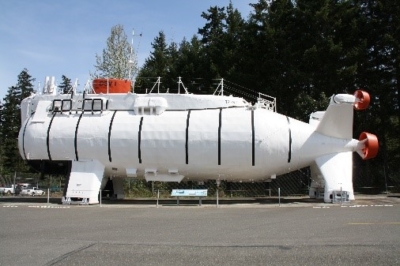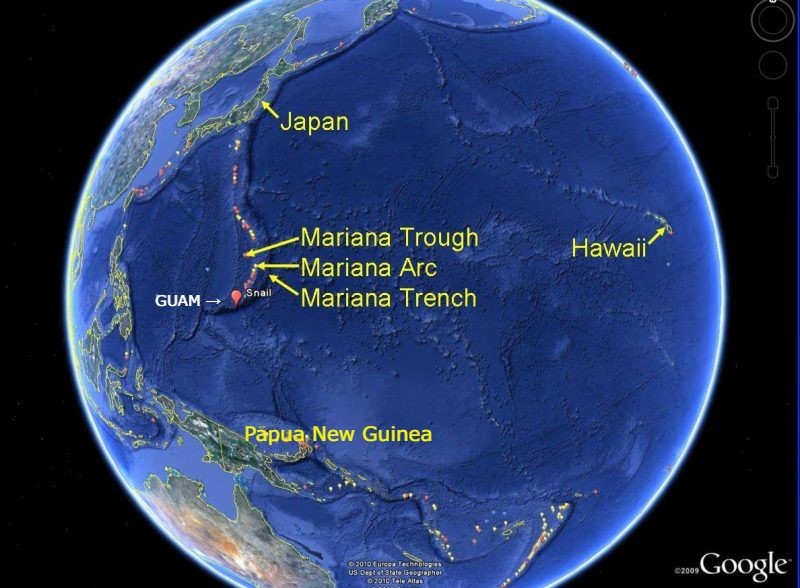By Maurice Williams and Peter Darcy
It is good to be reminded now and then of what an amazing and beautiful world we live in. For example, if you’ve ever seen the Grand Canyon and thought it was impressive, you would be even more amazed at the monster trench deep in the Pacific Ocean that makes the hole in Arizona’s landscape look like a child’s scratching.
That gash in the earth’s crust is called the Mariana Trench, and it is located between Japan and Papua New Guinea. It must be the most incredible natural site on the planet. It lies 124 miles from the closest land mass, the Mariana Islands, which run parallel to the arc of the trench as if they were formed in the same volcanic upheaval millions of years ago. Hence the name.
There’s only one problem. You can go to the edge of the Grand Canyon and look down into it, but you can’t even see the Mariana Trench, at least not from the water’s surface: this trench is almost seven miles under water!
In fact, only if you go high enough into space with the proper instruments can you make out the general contours of the trench (see photo below). Even on the brightest day, it is too far below the surface with too much saline water obscuring the picture to discern its size. Thankfully, though, science can help us know a few things about this amazing natural phenomenon.
Tectonic Plates
The trench was formed by the juncture of two massive tectonic plates that comprise the crust of the earth in that area: the Pacific plate and the Mariana plate. The plates collide, and the pressure causes one of the plates, the Pacific, to dive beneath the other and melt into the subterranean lava. The result is a deep rift in the earth’s crust. In fact, it is the deepest that we know of.
The Tectonic Plate Theory was first described in 1915 by Alfred Wegener, who noticed that the Eastern coasts of Europe and Africa appear to have matching contours to the Western coast of North and South America, The theory was not generally accepted by geologists until around 1960.
The Mid-Atlantic Ridge was one of the observations that confirmed the theory. The Mid-Atlantic Ridge is a long, interlinking series of mountain ranges running north and south on the floor of the Atlantic Ocean where two tectonic plates meet, somewhat messily. In this case, the plates are slowly pulling apart allowing fresh lava to emerge and solidify into a long scar which fills in the valley between the mountain-like edges of the plates. It’s the opposite dynamic than the one that formed the Mariana Trench in the Pacific, where the plates are colliding.
The earth is the only planet known so far to have tectonic plates that drift. That is due to our planet’s molten core. If a planet or moon is known to be cold, of course, there would be no plates because there is no molten core. Other, larger planets that have molten centers probably have moving plates but no data exists to confirm this.
Miles-Feet-Inches
Immensity is Mariana’s middle name. Let’s get some more perspective on its depth and size.
Can you visualize 6.8 miles…below sea level? To be precise, the trench lies 36,037 feet below the ocean’s surface. To put a picture on that depth, earth’s highest mountain peak, Mount Everest in Nepal, rises to 29,035 feet, which means that you could place Mount Everest entirely in the trench and still have more than a mile of water between the mountain’s summit and the surface of the ocean!
Or try this: the world’s tallest building is the Burj Khalifa in Dubai, standing at 2,722 ft. You would have to stack thirteen and a quarter Burj Khalifas end to end to reach the bottom of the trench. That’s also 21 former World Trade Centers (NY, 1727 ft.); 25 Sears Towers (Chicago, 1454 ft.); 29 Empire State Buildings (NY, 1250 ft.); and so forth.
As any good philosopher would say: That’s deep.
Even if you got to that depth – as only a few sea creatures and a couple of explorers have – you would see only a very small portion of the trench at a time because it is 1500 miles long and 43 miles wide. Compare that to the Grand Canyon, which is a paltry 277 miles from end to end and 18 miles wide.
Let’s get one more perspective on the trench’s immensity: its length of 1500 miles is the distance between Miami, Florida and Burlington, Vermont – essentially, the entire east coast of the US!
And you, my friend, are measured in inches.
On the subject of depth, this video is a very enlightening animation about how far down the ocean goes (duration, 3:04).
The Effects of Pressure
It would be an awe-inspiring sight if you could see the whole trench at a glance from the ocean’s surface, but the realities of the physical world are such that anyone descending into the depths would shrivel up from the pressure before the trench ever came into view.
Down to twenty feet below the surface, you can swim as much as you like and then back to the surface with no negative effects of pressure. But if you dive to around 100 feet, the water pressure reaches about 44 pounds per square inch. Think of what it would feel like to have a 44-pound dog (medium-sized) sitting on your chest.
It also means that when you surface, you would have to go through a decompression procedure to prevent nitrogen from forming minute bubbles of gas that can block blood flow in your capillaries. In other words, only the hardiest and best trained divers should go below twenty feet.
Now, imagine this…
At the depth of the Mariana Trench, the water pressure is an incredible 15,570 pounds per square inch. That pressure is great enough to compress your body into a peanut-size nugget of incredibly dense flesh and bone.
There are highly specialized submarines that could handle the pressure down at that depth, but unless you’re one of the tech billionaires of our world, you could not afford one.
The Challenger Deep
King David coined the phrase, “Deep calls unto deep” (Psalm 42:7), and that is certainly the case with the remotest region of the Mariana Trench. It is appropriately called the Challenger Deep.
 There have been four manned and half a dozen unmanned descents into the depths of the trench. Incredibly, they found trash at the bottom: a candy wrapper and a plastic bag, as well as elevated concentrations of PCBs (plastic contaminants). Nor can we discount other types of waste in the future: there are also plans to use Challenger Deep as a dump for spent radioactive fuel from nuclear power plants.
There have been four manned and half a dozen unmanned descents into the depths of the trench. Incredibly, they found trash at the bottom: a candy wrapper and a plastic bag, as well as elevated concentrations of PCBs (plastic contaminants). Nor can we discount other types of waste in the future: there are also plans to use Challenger Deep as a dump for spent radioactive fuel from nuclear power plants.
The first manned vessel to descend into the trench was the Trieste (see image), manned by the American, Lt. Don Walsh of the U S Navy, and the French scientist Jacques Piccard. The expedition took place on January 23, 1960, and the descent took about five hours. The submergible vessel (known as a bathyscaphe) was simply allowed to sink on its own at a descent rate of about 120 ft./min.
At about 30,000 feet, the pressure of the deep actually cracked the vessel’s outer plexiglass window, which had to have put the fear of God into even those intrepid explorers. But, incredibly, they persevered.
After reaching the bottom, the Trieste remained on the sea floor for twenty minutes and observed the amazing sea creatures that were there, something scientists didn’t think could possibly exist at such a depth. Yet, there they were. They also discovered to their great surprise that currents even flow through the deepest part of the ocean.
Not wishing to tempt fate, the operators of the Trieste dumped ballast and allowed the natural buoyancy of the vessel to raise it to the surface. The return trip lasted about three hours and fifteen minutes.
Life Below the Surface
While we can’t physically go there, we can take a virtual voyage down to it, where, using our imagination, we can contemplate the trench without any risk of imploding or being eaten by a giant squid.
As we descend, looking out an imaginary porthole, we see that the water is getting very black. Then, as the vessel enters what is appropriately called the Twilight Zone for its waning light (650 to 3,300 feet below sea level), we notice strange, luminous spots outside the window. This is because marine life in the ocean, where there is little sunlight, generate light from small organs that emit bioluminescence, like fireflies, but in the blackness of the ocean much more beautifully.
Many life forms inhabit the Twilight Zone, and about 1500 species of fish and crustaceans emit some type of bioluminescence, which helps the animals find mates and food. These glowing animals are a beautiful sight to see, as they stand out against the pure black background.
Further down, we enter what is called the Midnight Zone (~7500 ft. down) due to its total lack of light, and still have to descend through the remaining 28,000+ feet of water to the bottom of the ocean. The journey will be one of total blackness.
(Note: over in the Atlantic, you would find the wreck of the Titanic at about 12,500 ft.)
Arriving at the bottom of the Challenger Deep, there is intense blackness, and the diving vessel is getting cold from the water temperature, hovering around the freezing point and dropping the longer you stay there.
You would think that the extreme pressure at the bottom of the trench would crush all forms of life, but using our search light, we see a number of living creatures scurrying about, though not abundant numbers at this depth. The internal pressure within the animals is the same as the surrounding sea.
We can see fish swimming that look like flatfish, about twelve inches long. We see deep-sea shrimp and a new species of giant one-celled, jelly-like animals classified as foraminifera that resemble giant amoebas reaching up to four inches in diameter. We can also see amphipods, which are like albino woodlice.
For a brief glimpse into some of the creatures at the bottom of the trench, see the one-minute video below.
Remembering King David again, we find it easy to pray, “Out of the depths I cry to you, O Lord, hear my prayer. Let your ears be attentive to the voice of my supplication” (Psalm 130:1-2).
Then we rise, refreshed, as if emerging from the bowels of the earth, which is exactly where we have been.

Soul Work
It is marvelous that the Good Lord created all these life forms as well as billions of stars and galaxies that mortal man will never see in this life. Even on planet earth we are only comfortable if we stay within our comfort zones, say, rising a mile high in the sky or descending twenty feet into the ocean. Going beyond those limits is actually hazardous to one’s health.
What is truly amazing, however, is the beauty and intelligence with which the universe is constructed and all without man’s input. It’s important to see ourselves as we really are vis à vis the natural world: strictly limited within our natural constraints.
Meditate today on your place in the universe and your citizenship on the planet we call earth. Even a short meditation like that should inspire humility and wonder, which are virtues that open us to God’s grace.
Then, give thanks for all God has given you and for your place in an amazing and beautiful world.





I wrote this article with great interest. It makes one wonder how many other fascinating things there are on this planet, that nobody ever gets the opportunity to see.
Thanks Maurice, I hope people learn a lot from your words.
This reminded me of Maria Esperanza’s statement that the earth’s core is out of balance.
Great article, Peter and Maurice!
You’re very kind, Maureen! That item about Maria Esperanza is very interesting. I’ll check it out. Peace and thanks.